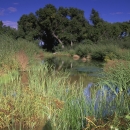About Us
The 2,765-acre refuge was established in 1988 to protect two of the eight native fish species of the Río Yaqui watershed: the Yaqui chub (Gila purpurea) and the Yaqui topminnow (Poeciliopsis sonoriensis). In addition, the refuge protects a unique velvet ash-black walnut-cottonwood forest along Leslie Creek that is important for many migrating and nesting birds.
It is 17.5 miles north of the international border with Mexico in southeast Arizona's Cochise County and is one of more than 560 National Wildlife Refuges, a federal network of lands and waters set aside for the benefit of wildlife
Our Mission
The mission of the National Wildlife Refuge System is to administer a national network of lands and waters for the conservation, management and, where appropriate, restoration of the fish, wildlife and plant resources and their habitats within the United States for the benefit of present and future generations of Americans.
Our Purpose
Every national wildlife refuge national wildlife refuge
A national wildlife refuge is typically a contiguous area of land and water managed by the U.S. Fish and Wildlife Service for the conservation and, where appropriate, restoration of fish, wildlife and plant resources and their habitats for the benefit of present and future generations of Americans.
Learn more about national wildlife refuge was created for a special purpose. Some were created to protect migratory birds, others to protect threatened or endangered species or unique habitats, while others fulfill another special purpose. Refuges are special places where wildlife comes first. All activities allowed on refuges must be evaluated to make sure each activity will not conflict with the reason the refuge was founded. Leslie Canyon National Wildlife Refuge serves to protect two fish species important to the Río Yaqui watershed: the Yaqui chub and the Yaqui topminnow. The refuge also protects a unique velvet ash-black walnut-cottonwood forest that provides important habitat for migrating and nesting birds.
Our History
1540—The Coronado expedition passes through the area in search of the fabled seven cities of Cibola.
1600s—The Apache begin to use this area for hunting and gathering.
1700s—Jesuit priests establish a mission in the San Bernardino Valley.
1889—Local bartender, gambler, cattleman, and three-time murderer Frank Leslie shot and killed his girlfriend on the 7-UP Ranch, escaping through what eventually became Leslie Canyon (named after him).
1988—Leslie Canyon National Wildlife Refuge was created.

